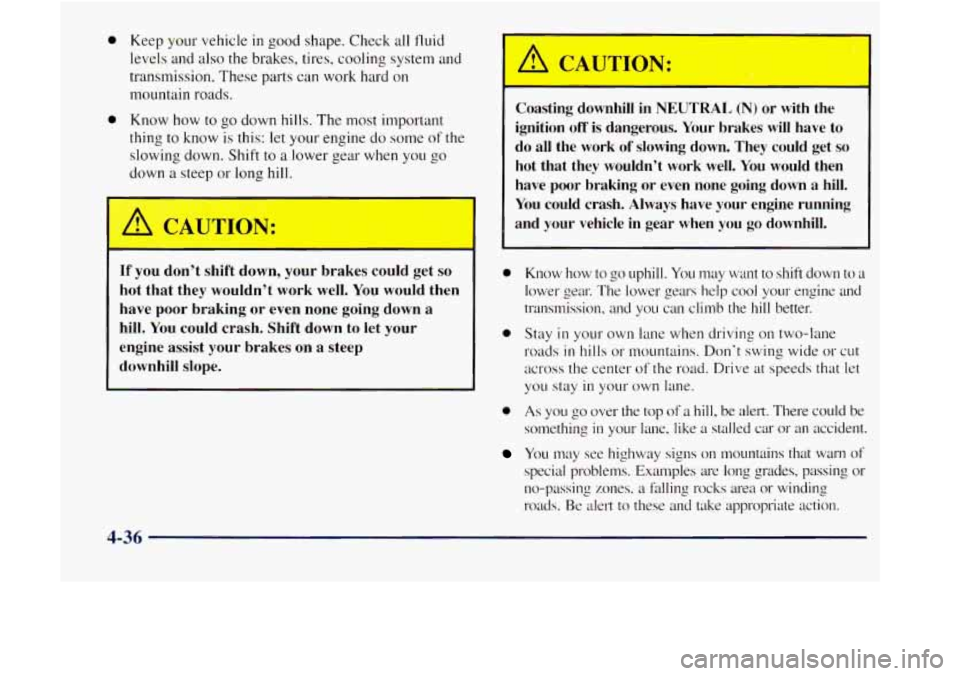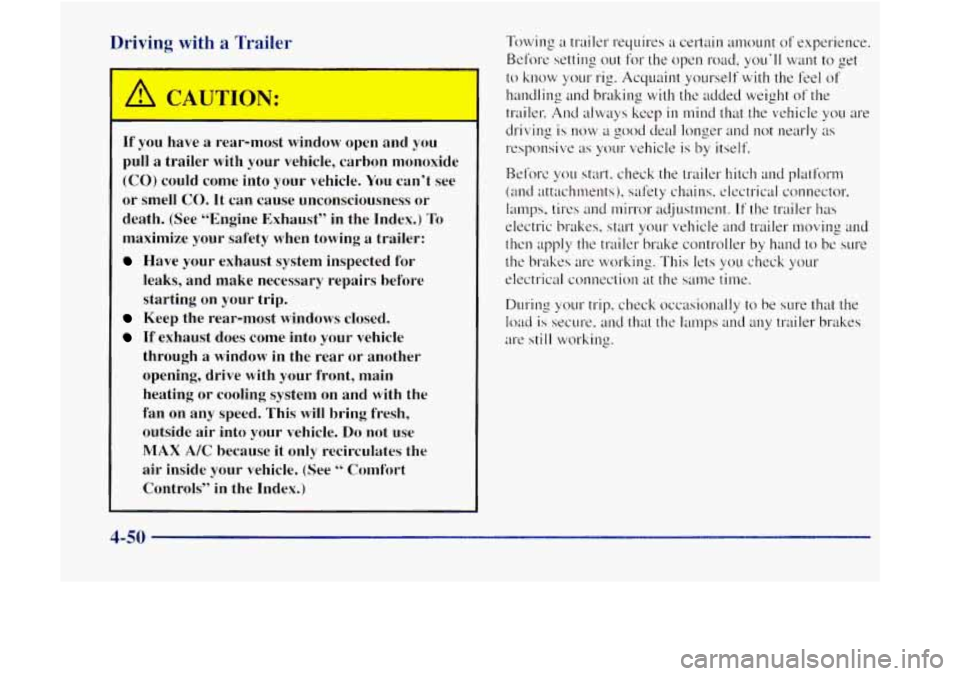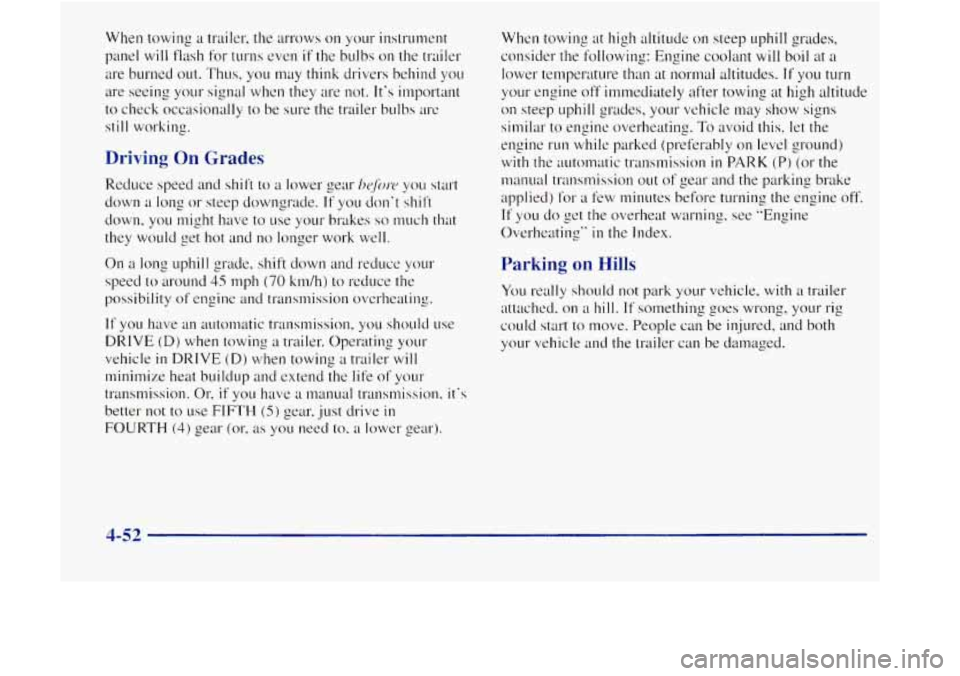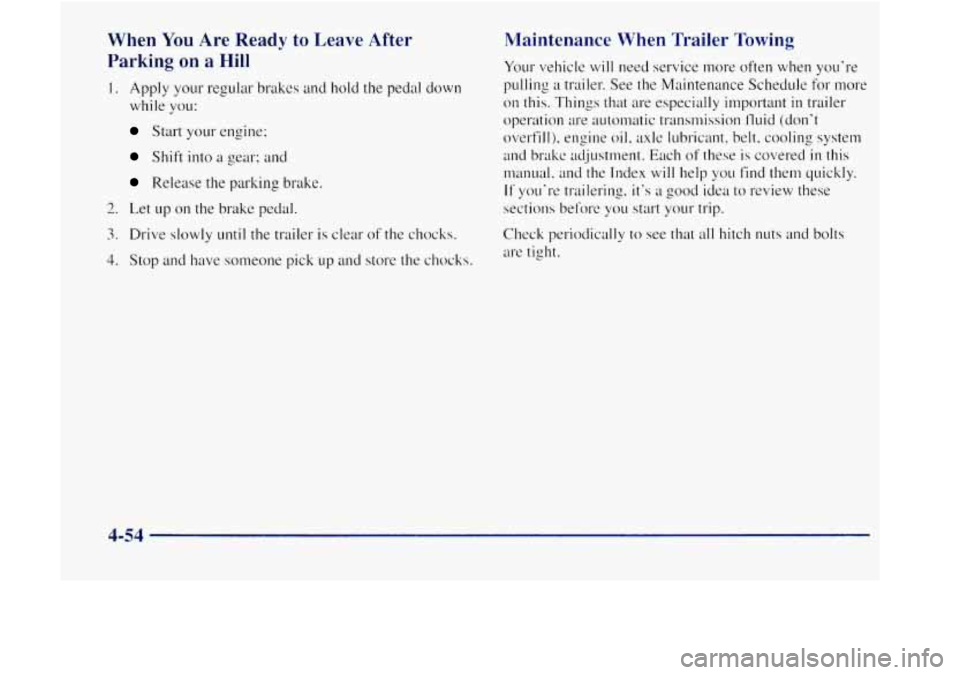engine GMC JIMMY 1997 Service Manual
[x] Cancel search | Manufacturer: GMC, Model Year: 1997, Model line: JIMMY, Model: GMC JIMMY 1997Pages: 410, PDF Size: 20.03 MB
Page 201 of 410

0
0
Keep your vehicle in good shape. Check all fluid
levels and also
the brakes, tires, cooling system and
transmission. These parts can work hard on
mountain roads.
Know
how to go down hills. The most important
thing to know is this:
let your engine do some of the
slowing down.
Shift to a lower gear when you go
down a steep or long hill.
If you don’t shift down, your brakes could get so
hot that they wouldn’t work well. You would then
have poor braking or even none going down
a
hill. You could crash. Shift down to let your
engine assist your brakes on
a steep
downhill slope.
A CAUTION: . -.
Coasting downhill in NEUTRAL (N) or with the
ignition
otf is dangerous. Your brakes will have to
do all the work
of slowing down. They could get so
hot that they wouldn’t work well. You would then
have poor braking or even none going down a hill.
You could crash. Always have your engine running
and your vehicle in gear when
you go downhill.
0 Know how to go uphill. You may want to shift down to a
lower gear. The lower gears help cool yo~~r engine and
transmission, and you can climb the hill better.
0 Stay in your own lane when driving on two-lane
roads
in hills or mountains. Don’t swing wide or cut
across the center
of the road. Drive at speeds that let
you stay
in your own lane.
0 As you go over the top of a hill, be alert. There could be
something
in your lane, like a stalled car or an accident.
You may see highway signs on nmuntains that warn of
special problems. Examples are long grades, passing or
no-passing zones. a falling rocks area or winding
roads.
Be alert to these and take appropriate action.
4-36
Page 204 of 410

If You’re Caught in a Blizzard 0 Tie a red cloth to your vehicle to alert police that
you’ve been stopped by the snow.
0 Put on extra clothing or wrap a blanket around you.
If you have no blankets or extra clothing, make body
insulators
f1-om newspapers, burlap bags, rags , floor
mats
-- anything you can wrap around yourself or
tuck under your clothing to keep warm.
If you are stopped by heavy snow. you could be in a
serious situation. You should probably stay with your
vehicle unless you know for sure that you are near help
and you can hike through the snow. Here are some
things
to do to summon help and keep yourself and your
passengers safe:
0 Turn on your hazard flashers.
You can run the engine to keep warm, but be careful.
4-39
Page 205 of 410

Snow can trap exhaust gases under your vehicle.
This can cause deadly
CO (carbon monoxide) gas
to get inside.
CO could overcome you and kill
you. You can’t see it or smell it,
so you might not
know it is in your vehicle. Clear away snow from
around the base of your vehicle, especially any
that is blocking your exhaust pipe. And check
around again from time to time to be sure snow
doesn’t collect there.
Open a window just a little on the side of the
vehicle that’s away from the wind. This will help
keep
CO out.
Run your engine only as long as you must. This saves
fuel. When
you run the engine, make it go a little faster
than just idle. That is, push the accelerator slightly.
This
uses less fuel for the heat that you get and it keeps the
battery charged.
You will need a well-charged battery to
restart the vehicle. and possibly for signaling later on
with your headlamps. Let the heater run for a while.
Then, shut the engine
off and close the window almost
all the way
to preserve the heat. Start the engine again
and repeat this only when you feel really uncomfortable
from the cold.
But do it as little as possible. Preserve the
fuel as long
as you can. To help keep warm, you can get
out of the vehicle and
do some hirly vigorous exercises
every half
hour or so until help comes.
4-40
Page 211 of 410

If You Do Decide To Pull A Trailer
If you do, here are some important points:
0
0
0
0
There are many different laws, including speed limit
restrictions, having to do with trailering. Make sure
your rig
will be legal, not only where you live but
also where you’ll be driving.
A good source for this
information can be state or provincial police.
Consider using a sway control
if your trailer will
weigh
2,000 lbs. (900 kg) or less. You should always
use a sway control
if your trailer will weigh more
than
2,000 lbs. (900 kg). You can ask a hitch dealer
about sway controls.
Don’t tow a trailer at all during the first
500 miles
(800 km) your new vehicle is driven. Your engine,
axle or other parts could be damaged.
Then, during the first
500 miles (800 km) that you
tow a trailer, don’t drive over
50 mph (80 km/h) and
don’t nuke starts at
full throttle. This helps your
engine and other parts
of your vehicle wear in at the
heavier loads.
If you have an automatic transmission, you can use
DRIVE
(D) (or, as you need to, a lower gear) when
towing
a trailer. Operating your vehicle in
DRIVE (D) when towing a trailer will minimize heat
buildup and extend the life
of your transmission. If
you have a manual transmission and you are towing
a trailer, it‘s better not to use FIFTH (5) gear. Just
drive
in FOURTH (4) gear (or, as you need to, a
lower gear).
Three important considerations have to do
with weight:
the weight of the trailer,
0 the weight of the trailer tongue
and the weight on your vehicle’s tires.
Weight of the Trailer
How heavy can a trailer safely be?
It depends on how you plan to use your rig. For
example, speed, altitude, road grades, outside
temperature and how much your vehicle
is used to pull a
trailer are all important. And,
it can also depend on any
special equipment that you have on your vehicle.
The following chart shows how much your trailer can
weigh, based upon your vehicle model and options.
4-46
Page 215 of 410

Driving with a Trailer
1 CAUTION:
If you have a rear-most window open and you
pull a trailer with your vehicle, carbon nlonoxide
(CO) could corne into your vehicle. You can’t see
or smell CO. It can cause unconsciousness or
death. (See “Engine Exhaust” in the Index.)
To
maximize your safety when towing a trailer:
Have your exhaust system inspected for
leaks, and make necessary repairs before
starting
on your trip.
Keep the rear-most windows closed.
If exhaust does come into your vehicle
through a window in the rear or another
opening, drive with your front, main
heating
or cooling system on and with the
fan on any speed.
This will bring fresh,
outside air into your vehicle. Do not use
MAX AX because it only recirculates the
air inside your vehicle. (See “ Comfort
Controls” in the Index.)
4-50
Page 217 of 410

When towing a trailer, the ~~rrows on your instrument
panel
will flash for turns even if the bulbs on the trailer
itre burned out. Thus. you may think drivers behind you
are seeing your signal when they are not. It's important
to check occasionally to be sure the trailer bulbs arc
still working.
Driving On Grades
On a long uphill grade, shift down and reducc your
speed
to around 45 mph (70 km/h) to reduce the
possibility
of engine and transmission ovc.rheating.
If you have an automatic transmission. you should use
DRIVE
(D) when towing a trailer. Operating your
vehicle
in DRIVE (D) when towing a trailer will
minimize heat buildup and extend the life
of your
trrmsmission. Or:
if you have ;1 manual transmission. it's
better not to use FIFTH (5) gear. just drive in
FOURTH (4) gear (or, as you need to, a I~MW gear). Whcn
towins at high altitude
on steep uphill grades,
consider the following: Engine coolant will boil at a
lower temperature than at normal altitudes. If yo^^ turn
your engine off immediately after towing
at high altitude
on steep uphill grades, your \:ellicle may show signs
similar to engine overheating.
To avoid this. let the
engine
r~~n while parked (preferably on level grout1d)
with the automatic transmission in PARK (Pj (or the
1manuaI transmission out of
gear and the parking brake
applied) 1'01-
;I few minutes before turning the engine off.
If you do get the overheat warning. see "Engine
Overheating"
in the Index.
Parking on Hills
You really should not park your vehicle. with a trailer
attached.
on a hill. If something goes wrong, your rig
could start
to move. People can be injured, and both
yo~~r vehicle and the trailer can
be damaged.
4-52
Page 218 of 410

1.
L. 7
3.
4.
5.
6.
Apply your regultu- brakes, but don‘t shift into
PARK (P) yet. or into gear for a nxmual
transmission. Then
t111-n your wheels into the curb if
facing downhill or into traffic if facing uphill.
Have someone place chocks under the trailer wheels.
When the wheel chocks are in place, release the
regular
brakes until the chocks absorb the load.
Reapply the reglrlar brakes. Then apply your parking
brake,
and then shift into PARK (P). or
REVERSE (R) for a manual transmission.
If yo^^ have ;t I’our-~yheel-dl-ive \:ellick with a
manual transfer case shift lever, be SLIR the transfer
case
is in a drive gear -- not in NEUTRAL (N).
Release the regular brakes. It can
be dangerous to get out of your vehicle
if
the shift lever is not fully in PARK (P) with the
parking brake firmly set. Your vehicle can
roll.
If you have left the engine running, the vehicle
can move suddenly. You
01- others could be
injured.
‘li) be sure your vehicle won’t n~ove, even
when you’re
on fairly level ground, use the steps
that follow.
If you have four-wheel drive with
a nlanual
transfer case shift lever and your transfer case
is
in NEUTRAL (N), your vehicle will he free to
roll, even
if your shift lever is in PARK (P). So, be
sure the transfer case is in a drive gear
-- not in
NEUTRAL (N).
4-53
Page 219 of 410

When You Are Ready to Leave After
Parking on
a Hill
I, Apply your reg~~lar brakes and lwld the pedal down
while you:
Start your engine;
Shift into a gear: and
Release the parking brake.
2. Let up on the brake pedal.
3. Drive slowly until the trailer is clear of the chocks.
4. Stop and have someone pick up and store the chocks.
Maintenance When Trailer Towing
Your vehicle will need service nlore often when you're
pulling a trailer. See the Maintenance Schedule for more
on
this. Things that are especially important in trailer
operation
are automatic transmission fluid (don't
overfill), engine
oil. ~~xle lubricant, belt, cooling system
and
brakc adjustment. Each of these is covered in this
manurd.
and the Index will help you find then] quickly.
If you're trailering. it's a good idea to review these
sections before you start your trip.
Check periodically
to see that all hitch nuts and bolts
are tight.
4-54
Page 222 of 410

Section 5 Problems on the Road
5 -2
s -2
5-3
5-7
5-12
5-22 Engine Fan Noise
5-23 Changing a Flat Tire
5-35 Compact Spare ’Tire (If Equipped)
5-36 If YOLI’I-~ Stuck: In Sand. Mud,
5-22 If a Tire Goes Flat
Ice or Snow
5-1
Page 225 of 410

2. Get the vehicles close enough so the jumper cables
can reach, but
be sure the vehicles aren*t touching
each other.
If they are, it could cause a ground
connection you don't want.
You wouldn't be able to
start your vehicle,
and the bad grounding could
damage the electrical systems.
You co~~ld
be injured if the vehicles roll. Set the
parking
brake firmly on each vehicle. Put an
automatic transmission in PARK (P) or a manual
transmission
in NEUTRAL (N). If you have a
four-wheel-drive vehicle with a manual transfer case
shift lever, be sure
the transfer case is not in
NEUTRAL (Nj.
3. Turn off the ignition on both vehicles. Unplug
unnecessary accessories plugged into the ci, wsette
lighter, or accessory power outlets,
if you have this
option. Turn off all
lamps that aren't needed as well
as radios. This will avoid sparks and help save both
batteries.
In addition, it could save your radio!
I NOTICE:
If' you leave your radio on, it could be badly
damaged, The repair wouldn't be covered by
your warranty.
An electric fan can start up even when the engine
is not running and can injure you. Keep hands,
clothing and tools
away from any underhood
electric fan.
- -
If your vehicle has air conditioning, the auxiliary
electric fan under the hood can start up
even
when the engine is not running and can injure
you. Keep hands, clothing and tools away from
any underhood electric fan.
5-4